Thistle
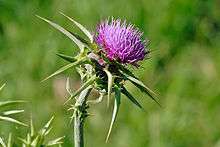
Thistle is the common name of a group of flowering plants characterised by leaves with sharp prickles on the margins, mostly in the family Asteraceae. Prickles occur all over the plant – on the stem and flat parts of leaves. They are an adaptation that protects the plant from being eaten by herbivores. Typically, an involucre with a clasping shape of a cup or urn subtends each of a thistle's flowerheads.
The term thistle is sometimes taken to mean exactly those plants in the tribe Cardueae (synonym: Cynareae),[1] especially the genera Carduus, Cirsium, and Onopordum.[2] However, plants outside this tribe are sometimes called thistles, and if this is done thistles would form a polyphyletic group.
A thistle is the floral emblem of Lorraine and Scotland, as well as the emblem of the Encyclopædia Britannica.
Taxonomy
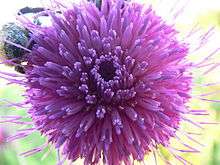
Genera in the Asteraceae with the word thistle often used in their common names include:
- Carduus – musk thistle and others
- Carlina – carline thistle
- Carthamus – distaff thistle
- Centaurea – star thistle
- Cicerbita – sow thistle
- Cirsium – common thistle, field thistle and others
- Cnicus – blessed thistle
- Cynara – artichoke, cardoon
- Echinops – globe thistle
- Notobasis – Syrian thistle
- Onopordum – cotton thistle, also known as Scots or Scotch thistle
- Scolymus – golden thistle or oyster thistle
- Silybum – milk thistle
- Sonchus – sow thistle
Plants in families other than Asteraceae which are sometimes called thistle include:
- Kali – Russian thistle, Tartar thistle, or tumbleweed, plants formerly classified in the genus Salsola (family Chenopodiaceae)
- Argemone mexicana – flowering thistle, Mexican prickly poppy
Economic significance
Thistles, even if one restricts the term to members of the Asteraceae, are too varied a group for generalisation; many are troublesome weeds, including some invasive species of Cirsium, Carduus, Silybum and Onopordum.[3] Typical adverse effects are competition with crops and interference with grazing in pastures, where dense growths of spiny vegetation suppress forage plants and repel grazing animals from eating either the thistle plants or neighbouring forage. Some species, although not intensely poisonous, do affect the health of animals that swallow more than small amounts of the material.[4][5]
Conversely however, the genus Cynara includes commercially important species of artichoke and some species regarded as major weeds are commercial sources of vegetable rennet used in commercial cheese making.[6] Similarly, some species of Silybum that occur as weeds, also are cultivated for seeds that yield vegetable oil and pharmaceutical compounds such as Silibinin.[7][8][9]
Other thistles that nominally are weeds are important honey plants, both as bee fodder in general, and as sources of luxury monofloral honey products.[3][10][11]
Ecology
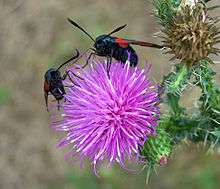
Thistle flowers are favourite nectar sources of the pearl-bordered fritillary, small pearl-bordered fritillary, high brown fritillary, and dark green fritillary butterflies.[12] Thistles (and thistle-seed feeders) also attract goldfinches.
Some thistles (for example Cirsium vulgare, native to Eurasia), have been widely introduced outside their native range.[13] Control measures include Trichosirocalus weevils, but a problem with this approach, at least in North America, is that the introduced weevils may affect native thistles at least as much as the desired targets.[14]
Thistles have been said to be very important nectar sources for pollinators. Some ecological organizations, such as the Xerces Society, have attempted to raise awareness of their benefits, to counteract the general agricultural and home garden labeling of thistles as unwanted weeds. The monarch butterfly, Danaus plexippus for instance, was highlighted as traditionally relying upon taller large-flowered thistle species such as Tall thistle, Cirsium altissimum, for its migration.[15] Although such organizations focus on the benefits of native thistles, certain non-native thistles, such as Cirsium vulgare in North America, may provide similar benefits to wildlife. Some prairie and wildflower seed production companies supply bulk seed for native North American thistle species, for wildlife habitat restoration, although availability tends to be low. Thistles are particularly valued by bumblebees for their high nectar production. Cirsium vulgare ranked in the top 10 for nectar production in a UK plants survey conducted by the AgriLand project which is supported by the UK Insect Pollinators Initiative.[16] Bull thistle was also a top producer of nectar sugar in another study in Britain, ranked third with a production per floral unit of (2323 ± 418μg).[17]
Medical uses
Maud Grieve recorded that Pliny and medieval writers had thought it could return hair to bald heads and that in the early modern period it had been believed to be a remedy for headaches, plague, canker sores, vertigo, and jaundice.[18]
Heraldry
Scottish thistle
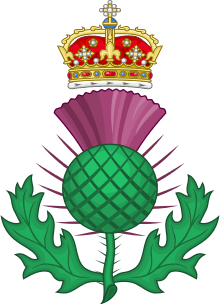
The thistle has been the national emblem of Scotland since the reign of Alexander III (1249–1286) and was used on silver coins issued by James III in 1470. It is the symbol of the Order of the Thistle, a high chivalric order of Scotland. It is found in many Scottish symbols and as the name of several Scottish football clubs. The thistle, crowned with the Scottish crown, was the symbol of seven of the eight former Scottish Police Services (from which a new national Police Service, Police Scotland, was formed in 2013), the sole exception being the former Northern Constabulary. The thistle is also the emblem of Encyclopædia Britannica, which originated in Edinburgh, Scotland.
It is also used to symbolise connection with Scotland overseas. For example, in Canada, it is one of the four floral emblems on the flag of Montreal; in the US, Carnegie Mellon University features the thistle in its crest in honour of the Scottish heritage of its founder, Andrew Carnegie.
According to a legend, an invading Norse army was attempting to sneak up at night upon a Scottish army's encampment. During this operation one barefoot Norseman had the misfortune to step upon a thistle, causing him to cry out in pain, thus alerting Scots to the presence of the Norse invaders. Some sources suggest the specific occasion was the Battle of Largs, which marked the beginning of the departure of King Haakon IV (Haakon the Elder) of Norway who, having control of the Northern Isles and Hebrides, had harried the coast of the Kingdom of Scotland for some years.[19] Which species of thistle is referred to in the original legend is disputed. Popular modern usage favours cotton thistle (Onopordum acanthium), perhaps because of its more imposing appearance, though it is unlikely to have occurred in Scotland in medieval times; the spear thistle (Cirsium vulgare), an abundant native species in Scotland, is a more likely candidate.[20][21] Other species, including dwarf thistle (Cirsium acaule), musk thistle (Carduus nutans), and melancholy thistle (Cirsium heterophyllum) have also been suggested.[22]
Thistle of Lorraine
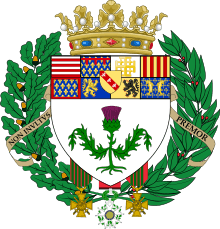
The thistle, and more precisely Onopordum acanthium, is one of the symbols of Lorraine, together with its coat of arms which displays three avalerions, and the Cross of Lorraine.
Lorraine is a region located in northeastern France, along the border with Luxembourg and Germany. Before the French Revolution, a large part of the region formed the Duchy of Lorraine. In the Middle Ages, the thistle was an emblem of the Virgin Mary because its white sap would bring to mind the milk falling from the breast of the Mother of God. It was later adopted as a personal symbol by René of Anjou, together with the Cross of Lorraine, then known as the Cross of Anjou. It seems through his book Livre du cuer d'amours espris that the Duke chose the thistle as his emblem not only because it was a Christian symbol, but also because he associated it with physical love.[23]
The thistle and the cross were used again by his grandson, René II, Duke of Lorraine, who introduced them in the region. The two symbols became hugely popular among the local people during the Battle of Nancy in 1477, during which the Lorrain army defeated Burgundy. The Duke's motto was "Qui s'y frotte s'y pique", meaning "who touches it, pricks oneself", with a similar idea to the Scottish motto "Nemo me impune lacessit". Nowadays the thistle is still the official symbol of the city of Nancy, as well as the emblem of the AS Nancy football team, and the Lorraine Regional Natural Park.[24][25]
Place names
Carduus is the Latin term for a thistle (hence cardoon, chardon in French), and Cardonnacum is the Latin word for a place with thistles. This is believed to be the origin of name of the Burgundy village of Chardonnay, Saône-et-Loire, which in turn is thought to be the home of the famous Chardonnay grape variety.
References
- ↑ "Cardueae". Tree of Life webproject. Retrieved 30 October 2012.
- ↑ "Thistle". Merriam-Webster's online dictionary. Retrieved 30 November 2007.
- 1 2 Rakesh Kumar Gupta, Wim Reybroeck, Johan W. Veen and Anuradha Gupta. Beekeeping for Poverty Alleviation and Livelihood Security. Springer. pp. 47–. ISBN 978-94-017-9199-1.
- ↑ W. T. Parsons; Eric George Cuthbertson (2001). Noxious Weeds of Australia. Csiro Publishing. pp. 189–. ISBN 978-0-643-06514-7.
- ↑ Watt, John Mitchell; Breyer-Brandwijk, Maria Gerdina: The Medicinal and Poisonous Plants of Southern and Eastern Africa 2nd ed Pub. E & S Livingstone 1962
- ↑ Vioque, M., et al. (2000). Chemical and microbiological characteristics of ewes' milk cheese manufactured with extracts from flowers of Cynara cardunculus and Cynara humilis as coagulants. Journal of Agricultural and Food Chemistry 48(2), 451–56.
- ↑ Pepping J. Milk thistle: Silybum marianum. Am J Health Syst Pharm. 1999 Jun 15;56(12):1195-7. PubMed PMID 10484652.
- ↑ Laekeman G, De Coster S, De Meyer K. [St. Mary's Thistle: an overview]. J Pharm Belg. 2003;58(1):28–31. Review. French. PubMed PMID 12722542.
- ↑ Ali ALEMARDAN, Anestis KARKANIS, Reza SALEHI. Breeding Objectives and Selection Criteria for Milk Thistle (Silybum marianum (L.) Gaertn.) Improvement. Not Bot Horti Agrobo, 2013, 41(2):340–347 Print ISSN 0255-965X; Electronic ISSN 1842-4309
- ↑ C. Marina Marchese; Kim Flottum (4 June 2013). The Honey Connoisseur: Selecting, Tasting, and Pairing Honey, With a Guide to More Than 30 Varietals. Black Dog & Leventhal Publishers. pp. 206–. ISBN 978-1-60376-332-5.
- ↑ Technical Bulletin. The Department. 1940. pp. 5–.
- ↑ Bracken for Butterflies Archived 3 October 2008 at the Wayback Machine. leaflet c0853 by Butterfly Conservation, January 2005
- ↑ Cirsium vulgare (Savi) Ten., Asteraceae , Pacific Island Ecosystems at Risk (PIER)
- ↑ Takahashi, Masaru; Louda, SM; Miller, TE; O'Brien, CW (2009). "Occurrence of Trichosirocalus horridus (Coleoptera: Curculionidae) on Native Cirsium altissimum Versus Exotic C. Vulgare in North American Tallgrass Prairie". Environmental Entomology. 38 (3): 731–40. doi:10.1603/022.038.0325. PMID 19508782.
- ↑ Eckberg, James; Lee-Mäder, Eric; Hopwood, Jennifer; Foltz Jordan, Sarah; Borders, Brianna (2017). "Native Thistles: A Conservation Practitioner's Guide". The Xerces Society. The Xerces Society. Retrieved 27 August 2018.
- ↑ "Which flowers are the best source of nectar?". Conservation Grade. 2014-10-15. Retrieved 2017-10-18.
- ↑ Hicks, DM; Ouvrard, P; Baldock, KCR (2016). "Food for Pollinators: Quantifying the Nectar and Pollen Resources of Urban Flower Meadows". PLoS ONE. 11 (6). doi:10.1371/journal.pone.0158117.
- ↑ Grieve, Maud. "A Modern Herbal". Retrieved 3 June 2011.
- ↑ Webmaster, John Duncan (4 April 2009). "Scots History Online". UK: Scots History Online. Retrieved 14 January 2013.
- ↑ "Flowers of Scotland: Thistle". Twocrows.co.uk. Retrieved 14 January 2013.
- ↑ "Why is the THISTLE a Scottish national symbol?". Ormiston.com. Retrieved 14 January 2013.
- ↑ "Scotland Fact File: The Thistle". Visitscotland.com. Retrieved 14 January 2013.
- ↑ Christian Pfister (1908). Histoire de Nancy. 1. Berger-Levrault. p. 554.
- ↑ "Le chardon". Tela Botanica. Retrieved 11 February 2017.
- ↑ "Origine du blason de Nancy". Nancy WebTV. Retrieved 11 February 2017.
External links
| Wikimedia Commons has media related to thistles. |
| Look up thistle in Wiktionary, the free dictionary. |
![]()
- "Lily-Bell and Thistle-down" (a fairy tale) in Flower Fables by Louisa May Alcott (1855)
- Allen, Charles Grant Blairfindie (November 1886). "Thistles". Popular Science Monthly. 30.
- "Thistle". Encyclopædia Britannica (11th ed.). 1911.
- "Thistle-Down" (a poem) in Flint and Feather by E. Pauline Johnson (1912)